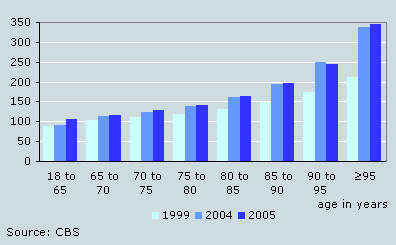Home care 2005: fewer clients, more hours of care provided

Relative to 2004, the number of persons aged 18 years or older who received AWBZ-financed home care in 2005, decreased by over 12 thousand (2 percent) to 596 thousand. Notwithstanding the decrease, the amount of home care hours provided in 2005 grew by 1 percent.
Fewer women under 85 receive home care
The reduction in home care clients in 2005 mainly occurs among women under the age of 85. Among over-85s, there is an increase in male as well as female home care clients. This is partly due to the fact that older people live independently longer.
From the age of 90, the number of home care clients declines as a substantial part of over-90s live in nursing homes and homes for the elderly.
Proportion in the population receiving home care by age

Number of home care hours per client continues to increase
Despite the reduction in the number of home care clients, the total number of home care hours provided grew 1 percent in 2005.
The average number of home care hours per client rose by 5 hours (3.2 percent) to 152 hours in 2005. In 1999, the average home care client received 122 hours of care. The so-called extramuralisation process is partly accountable for the growing number of home care hours provided. This process has an increasing effect on the average need for home care.
Average number of home care hours received per person by age

Decrease after increase
The number of home care recipients fell dramatically in 2005. In the period 1999–2004, the number of persons over 18 receiving AWBZ-financed home care still increased by 22 percent.
The decrease may only be temporary. Provisional figures published by the Central Administration Office Exceptional Medical Expenses (CAK-BZ) indicate that the number of home care recipients is slightly increasing again in 2006.
Mirthe de Groot